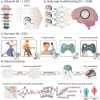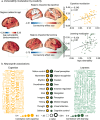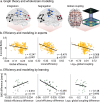Creative experiences and brain clocks
- PMID: 41044135
- PMCID: PMC12494922
- DOI: 10.1038/s41467-025-64173-9
Creative experiences and brain clocks
Abstract
Creative experiences may enhance brain health, yet metrics and mechanisms remain elusive. We characterized brain health using brain clocks, which capture deviations from chronological age (i.e., accelerated or delayed brain aging). We combined M/EEG functional connectivity (N = 1,240) with machine learning support vector machines, whole-brain modeling, and Neurosynth metanalyses. From this framework, we reanalyzed previously published datasets of expert and matched non-expert participants in dance, music, visual arts, and video games, along with a pre/post-learning study (N = 232). We found delayed brain age across all domains and scalable effects (expertise>learning). The higher the level of expertise and performance, the greater the delay in brain age. Age-vulnerable brain hubs showed increased connectivity linked to creativity, particularly in areas related to expertise and creative experiences. Neurosynth analysis and computational modeling revealed plasticity-driven increases in brain efficiency and biophysical coupling, in creativity-specific delayed brain aging. Findings indicate a domain‑independent link between creativity and brain health.
© 2025. The Author(s).
Conflict of interest statement
Competing interests: The authors declare no competing interests.
Figures





References
-
- Chen, W. G. et al. Music and medicine: quickening the tempo of progress. Lancet403, 1213–1215 (2024). - PubMed
-
- Morgan, J. Music lives on: fine tuning the memory. Lancet Neurol.17, 211–212 (2018).
-
- Sihvonen, A. J. et al. Music-based interventions in neurological rehabilitation. Lancet Neurol.16, 648–660 (2017). - PubMed
-
- Bavelier, D. & Green, C. S. Enhancing attentional control: lessons from action video games. Neuron104, 147–163 (2019). - PubMed
MeSH terms
Grants and funding
LinkOut - more resources
Full Text Sources
Medical
Miscellaneous

